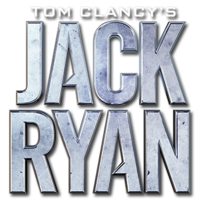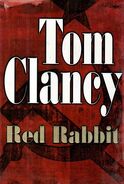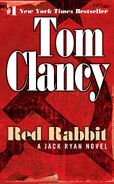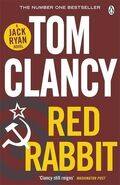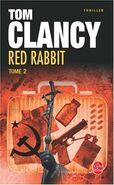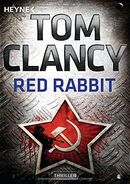|
This article is about a novel.
|
This article, Red Rabbit, is a stub and may require expansion. Please help out by editing the page.
|
Red Rabbit (2002) is a New York Times bestselling novel by Tom Clancy. It revolves around the 1981 plot to assassinate Pope John Paul II. The story incorporated several historical events, including the 1978 assassination of Georgi Markov and the World War II era Operation Mincemeat.
Plot[]
In 1982, Pope John Paul II privately issues a letter to the communist Polish government, stating that he will resign from the papacy and return to his hometown unless they cease their repression of counterrevolutionary movements in Poland, particularly the Solidarity trade union. Called the Warsaw Letter, it was later forwarded to Moscow, enraging Committee for State Security (KGB) director Yuri Andropov. He decides to plan for the pope’s assassination, which he believes would reinvigorate Communism in Eastern Europe, perceived by many to be in a state of decline. Known only by its designated number 15-8-82-666 for security reasons, the assassin is then selected as a Turkish Muslim, Mehmet Ali Ağca, who would then be eliminated by Bulgarian KDS officer Boris Strokov afterwards for deniability. The operation was later unanimously approved by the Politburo.
Meanwhile, Oleg Zaitzev, a communications officer in the KGB tasked with sending and receiving encrypted dispatches to and from KGB stations across Europe, pieces together the plot to kill the pope, and becomes deeply troubled with the prospect of murdering an innocent person for political purposes. He later decides to make contact with the local CIA station chief Edward Foley as well as his wife and agent Mary Pat Foley, intending to defect and then be extracted from the Soviet Union with his family, in exchange for providing information on the assassination plot as well as the names of KGB deep-penetration agents in the American and British governments.
The Foleys instruct Zaitzev to bring his family to Budapest, Hungary, under the guise of taking a vacation. They are then to be assisted by British Secret Intelligence Service (SIS) officers stationed in the city, because the CIA station there was compromised; as a result, Jack Ryan, former Marine and the CIA liaison to SIS back in London, was sent there to represent the agency. Early one morning, the Zaitzevs were spirited out of the hotel where they were staying. Accompanied by Ryan, they are then smuggled to Yugoslavia, whence they immediately fly to the United Kingdom. By then, SIS agents had planted dead bodies that are physically identical to the family into their hotel room, which was then set on fire, thus deceiving the KGB.
After settling down in a safehouse outside Manchester, Zaitzev reveals what he knows about the assassination plot, which alarms the SIS and the CIA. Ryan was later sent to St. Peter’s Square in Vatican City to accompany the British SIS officers on the ground to ascertain how the hit on the pope will play out, as well as to try capturing the shooter. At the pope’s weekly audience, Ryan manages to capture Strokov; however, the Pope gets shot anyway by the real shooter Ağca. Nevertheless, the pontiff recovers from his wounds. It was then revealed that Strokov was executed by the British as retaliation for murdering Soviet defector Georgi Markov on British soil four years ago.
Characters[]
Discrepancies[]
- If the novel is set in 1981 (when the real-life assassination attempt was made), then several historical references made in the novel would be anachronistic. However, there is evidence that Clancy has deliberately altered the real-world timeline, perhaps because the novel is set after Patriot Games, which itself is set after the birth of Prince William of Wales on 21 June 1982. In the novel, the original KGB order regarding assassination plan has the official reference "15-8-82-666". This places the assassination attempt sometime after 15 August 1982. This would put the events of Red Rabbit in 1983 or 1984 resolving most of the above issues, but moving the date of the assassination attempt a couple of years.
- A mention of Ronald Reagan firing striking air traffic controllers. The attempt to kill John Paul II happened on May 13, 1981. Reagan didn't fire the controllers until August 5, and the strike didn't even begin until August 3.
- A plane landing at London Heathrow Terminal 4, while Brezhnev is still head of the USSR. Terminal 4 did not open until 1986, after his death.
- A preschool-age character is a fan of “The Transformers” animated series, which did not debut until 1984.
- Coke Classic was not sold until 1985.
- Facts given concerning Cardinal József Mindszenty are inaccurate. While Clancy asserts that Mindszenty was detained during World War II, he was actually not a Cardinal at that point. He was also released following the end of the war and subsequently detained a few years later, unlike the account given in the story.
- In "The Sum Of All Fears" Ryan mentions he has never been to Rome before; however, he was present during the assassination attempt. This could be resolved due to the nature of his mission being classified. Ryan would have had to lie because not many people were cleared to know about both the Rabbit and the attempt.
- Jack Ryan mentions a lack of Starbucks during breakfast; in 1981 Starbucks had just a single Seattle location that didn't even sell coffee yet (just coffee beans). It is highly unlikely that Ryan would be aware of this tiny operation, let alone mention it to others in England and expect them to know what he was talking about.
- Mention of Reagan linking the Soviets with evil generally and calling the Soviet Union an "evil empire." Reagan made these references in a speech delivered March 8, 1983.
- References to a pint of English beer being 16 fluid ounces in the story are incorrect. While the US pint may be 16 ounces, the Imperial Pint used in the UK is actually 20 Imperial ounces (19.2 U.S. fluid ounces).
- References to Mikhail Suslov's ill health and death; Suslov didn't die until January 25, 1982, 8 months after the attempt to kill John Paul II.
- References to the 1978 murder of the Bulgarian dissident Georgi Markov by the Darzhavna Sigurnost misstate the location of the attack as Westminster Bridge. In fact, he was jabbed with a poisoned-pellet umbrella at Waterloo Bridge in London.
- References to the Falklands War, which took place in 1982, after the attempt to assassinate the Pope.
- References to York being the biggest city in the North of England are incorrect. Manchester is the biggest metropolitan area in the North of England and conurbations such as Leeds, Liverpool and Newcastle upon Tyne are also substantially more populous than York.
- The entire use of the AVH is inaccurate in the story. The AVH was abolished in the Hungarian Revolution of 1956 and, following the instatement of János Kádár, Hungary remained without an intelligence agency.
- There is much discussion of the baseball season by the characters.
- Some of the characters mention Cal Ripken, Jr. as a rookie at the major league level. While Ripken did make his major league debut in 1981, it wasn't until August 10.
- The Baltimore Colts are mentioned as having moved to Indianapolis when in fact they moved in 1984.
- The characters expect the Series to be between the Baltimore Orioles and the Philadelphia Phillies. This was the World Series match up for 1983, not 1981. The New York Yankees are mentioned as having an awful season when in fact they appeared in the World Series that year. The Yankees in 1983 finished 91-71, in 3rd place in the American League East. The bad season mentioned in the book may have been 1982, when they went 79-83 and came in 5th.
- The repeated description of Magyar (the Hungarian language) is debatable, with Clancy describing it as an Indo-Altaic language, while it is almost universally considered a Uralic language. Other facts about Magyar are dubious, including the assertion that the two European languages closest to Magyar are Finnish (generally accepted) and Mongolian (highly controversial), while Estonian is actually commonly accepted as a Uralic language and thus a closer relative.
- When attending a concert featuring Bach's Brandenburg Concertos, Ryan is impressed by the harpsichordist's ability to match his volume to the orchestra, yet harpsichords are incapable of varying the volume of struck notes, one reason the pianoforte ("soft-loud") was invented.
- Yuri Andropov is depicted as referring to Stalin as "the great Koba". "Koba" was a pseudonym used by Stalin early in his career, and it is improbable that it would be used in such a context. Andropov's government officially started the De-Stalinization movement.
Accuracies[]
- Cathy Ryan is appalled at the inefficiency of the top-down system of British government-run healthcare. This was during the era of Margaret Thatcher, who was critical of the expensive government programs, including single-payer medicine.
- MI6 and the CIA are appalled they know virtually nothing of Yuri Andropov. In actuality, Andropov was a secretive man, largely due to his position as KGB chief. Even after he died, many intelligence agencies and media outlets never even knew Andropov was married. (Tatiana Andropov died in November 1991).
- The Foleys, the married CIA agents assigned to Moscow, are mentioned as being appreciated at swap meets and other aspects of the underground Soviet economy as they pay in blue-stripe rubles issued as part of their CIA pay. Rubles with a blue stripe on the obverse (akin to the orange stripe seen on the American $100 bill) were only accepted at the elite stores, or places for the Party elite where quality goods could be found even in times of shortages. However, ordinary Soviet citizens who held a blue-stripe ruble note in hand were allowed to spend it at the elite stores.
